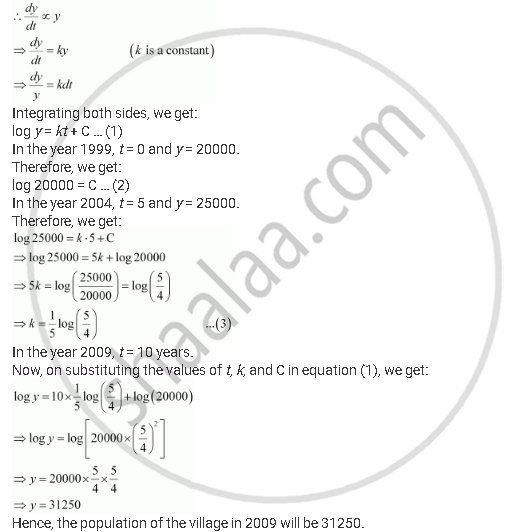Advertisements
Advertisements
प्रश्न
The population of a village increases continuously at the rate proportional to the number of its inhabitants present at any time. If the population of the village was 20000 in 1999 and 25000 in the year 2004, what will be the population of the village in 2009?
उत्तर
Let the population at any instant (t) be y.
It is given that the rate of increase of population is proportional to the number of inhabitants at any instant.

APPEARS IN
संबंधित प्रश्न
For the differential equation, find the general solution:
`dy/dx + 2y = sin x`
For the differential equation, find the general solution:
`cos^2 x dy/dx + y = tan x(0 <= x < pi/2)`
For the differential equation, find the general solution:
`x dy/dx + 2y= x^2 log x`
For the differential equation, find the general solution:
(1 + x2) dy + 2xy dx = cot x dx (x ≠ 0)
For the differential equation, find the general solution:
`(x + 3y^2) dy/dx = y(y > 0)`
For the differential equation given, find a particular solution satisfying the given condition:
`dy/dx + 2y tan x = sin x; y = 0 " when x " = pi/3`
For the differential equation given, find a particular solution satisfying the given condition:
`dy/dx - 3ycotx = sin 2x; y = 2` when `x = pi/2`
Solve the differential equation `x dy/dx + y = x cos x + sin x`, given that y = 1 when `x = pi/2`
(x + tan y) dy = sin 2y dx
dx + xdy = e−y sec2 y dy
Solve the differential equation \[\left( x + 2 y^2 \right)\frac{dy}{dx} = y\], given that when x = 2, y = 1.
Solve the differential equation \[\left( y + 3 x^2 \right)\frac{dx}{dy} = x\]
Solve the following differential equation:- \[\left( \cot^{- 1} y + x \right) dy = \left( 1 + y^2 \right) dx\]
Solve the following differential equation: \[\left( \cot^{- 1} y + x \right) dy = \left( 1 + y^2 \right) dx\] .
Find the integerating factor of the differential equation `xdy/dx - 2y = 2x^2` .
Solve the following differential equation:
`"dy"/"dx" + "y"/"x" = "x"^3 - 3`
Solve the following differential equation:
`("x" + 2"y"^3) "dy"/"dx" = "y"`
Solve the following differential equation:
`"x" "dy"/"dx" + "2y" = "x"^2 * log "x"`
Solve the following differential equation dr + (2r cot θ + sin 2θ) dθ = 0.
Solve the following differential equation:
y dx + (x - y2) dy = 0
Form the differential equation of all circles which pass through the origin and whose centers lie on X-axis.
The solution of `(1 + x^2) ("d"y)/("d"x) + 2xy - 4x^2` = 0 is ______.
The integrating factor of differential equation `(1 - y)^2 (dx)/(dy) + yx = ay(-1 < y < 1)`
Let y = y(x) be a solution curve of the differential equation (y + 1)tan2xdx + tanxdy + ydx = 0, `x∈(0, π/2)`. If `lim_(x→0^+)` xy(x) = 1, then the value of `y(π/2)` is ______.
If the solution curve y = y(x) of the differential equation y2dx + (x2 – xy + y2)dy = 0, which passes through the point (1, 1) and intersects the line y = `sqrt(3) x` at the point `(α, sqrt(3) α)`, then value of `log_e (sqrt(3)α)` is equal to ______.
If the slope of the tangent at (x, y) to a curve passing through `(1, π/4)` is given by `y/x - cos^2(y/x)`, then the equation of the curve is ______.
If sec x + tan x is the integrating factor of `dy/dx + Py` = Q, then value of P is ______.
The slope of tangent at any point on the curve is 3. lf the curve passes through (1, 1), then the equation of curve is ______.
